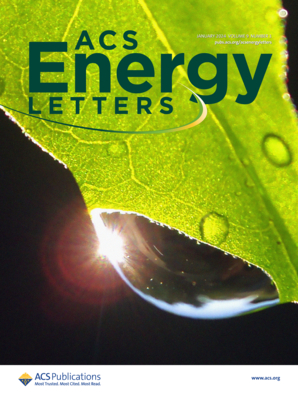Boosting Oxygen Evolution Reaction Performance on BiVO4 Photoanode via Gradient Oxygen Vacancies
IF 19.3
1区 材料科学
Q1 CHEMISTRY, PHYSICAL
引用次数: 0
Abstract
BiVO4 is extensively studied in photoelectrochemical water splitting systems. Its relatively large bandgap and low charge carrier mobility severely limit the solar-driven oxygen evolution reaction on BiVO4. A gradient distribution of oxygen vacancies can modulate the structural and electrical properties of BiVO4. However, the formation of oxygen vacancies remains a daunting challenge. Here, we propose a simple hydrothermal post-treatment method to deposit a thin amorphous BiOx layer (∼8 nm) with gradient oxygen vacancies on the surface of BiVO4 and enable directional hole migration. The resultant BiVO4/BiOx/NiFeOx photoanode achieves a high photocurrent density of 6.34 mA cm–2 at 1.23 V (vs RHE) in 1.0 M potassium borate solution. A solar-to-hydrogen conversion efficiency of 0.89% is obtained in a device using a BiVO4/BiOx/NiFeOx photoanode and a CuBi2O4 photocathode at zero bias. This work highlights a novel strategy for modulating the oxygen vacancy gradient and provides insights into the design of unbiased solar water splitting systems.

利用梯度氧空位提高BiVO4光阳极析氧性能
在光电化学分水系统中,对 BiVO4 进行了广泛的研究。其相对较大的带隙和较低的电荷载流子迁移率严重限制了 BiVO4 上由太阳能驱动的氧进化反应。氧空位的梯度分布可以调节 BiVO4 的结构和电学特性。然而,氧空位的形成仍然是一项艰巨的挑战。在此,我们提出了一种简单的水热后处理方法,在 BiVO4 表面沉积一层带有梯度氧空位的无定形 BiOx 薄层(∼8 nm),实现孔的定向迁移。在 1.0 M 硼酸钾溶液中,BiVO4/BiOx/NiFeOx 光阳极在 1.23 V(相对于 RHE)电压下实现了 6.34 mA cm-2 的高光电流密度。在零偏压条件下,使用 BiVO4/BiOx/NiFeOx 光阳极和 CuBi2O4 阴极的设备实现了 0.89% 的太阳能-氢气转换效率。这项工作强调了一种调节氧空位梯度的新策略,并为设计无偏太阳能水分离系统提供了启示。
本文章由计算机程序翻译,如有差异,请以英文原文为准。
求助全文
约1分钟内获得全文
求助全文
来源期刊

ACS Energy Letters
Energy-Renewable Energy, Sustainability and the Environment
CiteScore
31.20
自引率
5.00%
发文量
469
审稿时长
1 months
期刊介绍:
ACS Energy Letters is a monthly journal that publishes papers reporting new scientific advances in energy research. The journal focuses on topics that are of interest to scientists working in the fundamental and applied sciences. Rapid publication is a central criterion for acceptance, and the journal is known for its quick publication times, with an average of 4-6 weeks from submission to web publication in As Soon As Publishable format.
ACS Energy Letters is ranked as the number one journal in the Web of Science Electrochemistry category. It also ranks within the top 10 journals for Physical Chemistry, Energy & Fuels, and Nanoscience & Nanotechnology.
The journal offers several types of articles, including Letters, Energy Express, Perspectives, Reviews, Editorials, Viewpoints and Energy Focus. Additionally, authors have the option to submit videos that summarize or support the information presented in a Perspective or Review article, which can be highlighted on the journal's website. ACS Energy Letters is abstracted and indexed in Chemical Abstracts Service/SciFinder, EBSCO-summon, PubMed, Web of Science, Scopus and Portico.
 求助内容:
求助内容: 应助结果提醒方式:
应助结果提醒方式:


